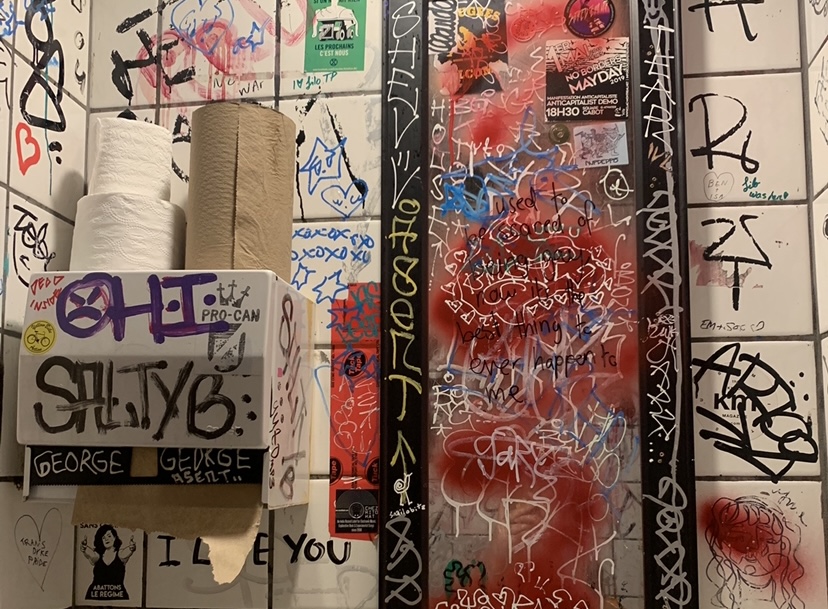The under-appreciated art of bathroom graffiti.
“Should I break up with my boyfriend?” was scrawled on the bathroom wall in Sharpie.
Underneath, an extensive list of pros and cons. In different inks and handwriting, others had replied: “DUMP HIM NOW!” “You deserve better!!!” and “Girl, run.”
This was all on the stall door of my CEGEP bathroom that I sometimes visited just to read the writing on the walls. I amused myself reading this make-shift discussion board, shaking my head at the man being described and nodding at the advice these helpful strangers had given. A few days later, the original scribe added a final word: “I broke up with him!”
Not long after, the entire bathroom was painted over in a coat of white paint, erasing this message chain as well as hundreds of other words and doodles. I was enraged. I have always had a fierce love for bathroom wall graffiti—I would argue that what schools might call vandalism is an art form and an important form of communication. It even has a scholarly term: latrinalia.
Latrinalia takes on so many forms, from declarations of love and other confessions to rude messages and random thoughts. The words can also be more serious, with political messages or pleas for advice. There is a stark contrast between serious messages and nonsensical scribblings. Intricate drawings sit beside crude sketches, and the notes often flip between earnest and irreverent. Because the form is entirely anonymous, people feel comfortable revealing secrets and being honest in their beliefs, which creates an ecosystem of thoughts and feelings.
In this sense, the graffiti becomes a communication method as an ongoing dialogue with total strangers. Messages of solidarity and camaraderie are common, and people sometimes ask for advice or start lists and tallies.
Bathroom graffiti is nothing new, either—in Pompeii, ancient graffiti revealed insults, jokes, and slogans. In The Guardian, Chiara Wilkinson writes: “Since ancient Rome, public bathroom scrawl – or latrinalia – has proved its power to entertain and enrage as well as highlighting society’s most divisive issues.”
It’s interesting to see which bathrooms on campus and across the city have the best graffiti. The women’s bathrooms on the third floor bathroom of the VA building and the second floor of the EV building are some of my favourites. Of course, bar bathrooms are excellent too; The Bar Le Ritz bathroom is a classic.
Bar bathrooms are particularly special because they tend to embrace the graffiti rather than paint over it. This isn’t always the case across campus, of course. “White paint is political” declares a stairwell in the VA that is repeatedly painted over in the quest for a blank wall. The relentless erasure is especially disappointing in an arts building—so long as the messages aren’t hateful, they should be respected. Who gets to decide what is valid art and what isn’t?
It might sound stupid, but bathroom graffiti is important. It’s a reflection of what’s on people’s minds—what brings us together, what divides us. It’s collaborative but also controversial, and I would even go so far as to call it a folk art. Its longevity is a testament to its power: humans were scratching “I was here” on the bathroom wall thousands of years ago and will continue to do so for as long as there’s a bathroom wall to write on.
On that note—mere days after a coat of white paint erased my favourite bathroom graffiti, the walls were again plastered with Sharpie and pen marks. Just as they should be.
